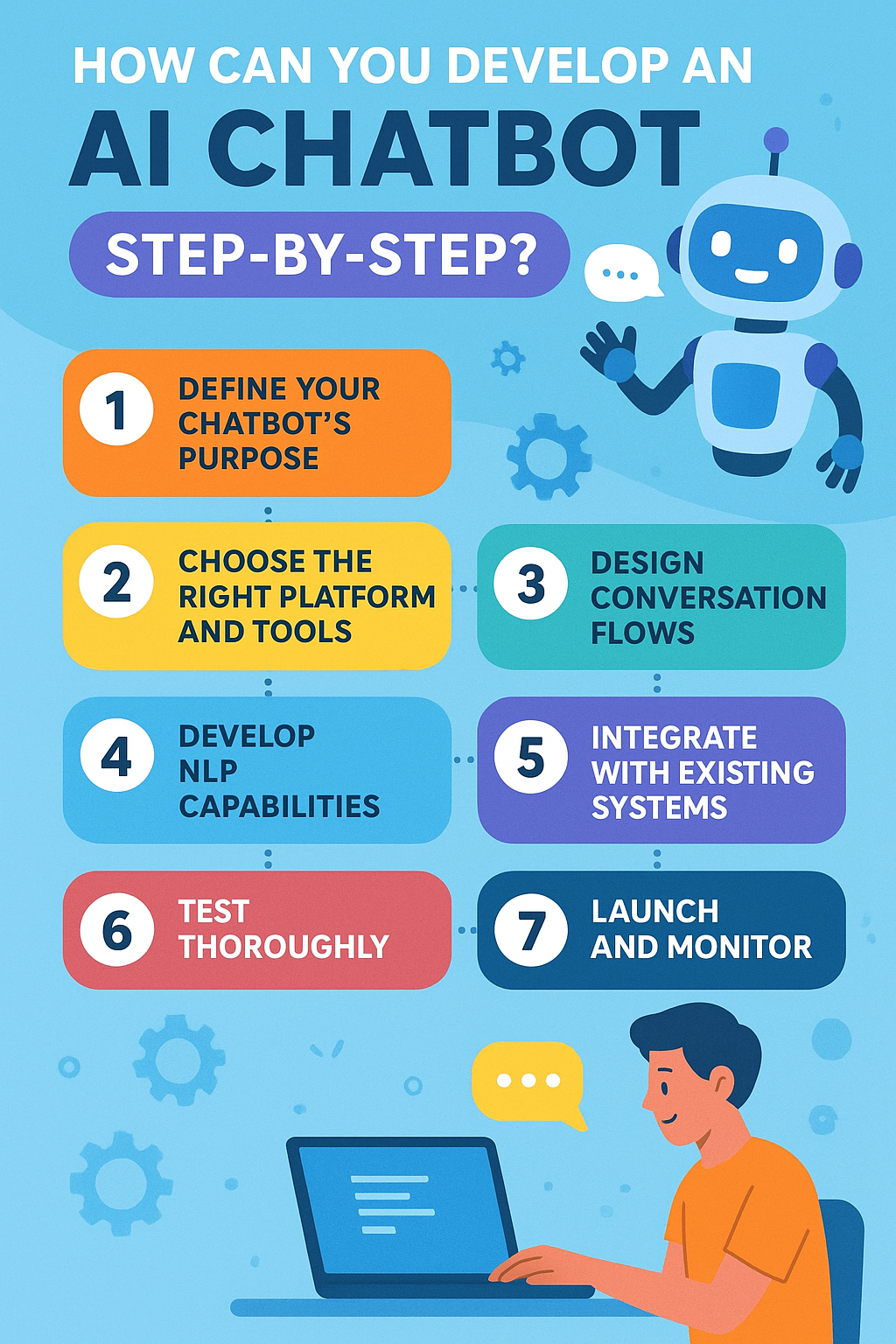In today’s fast-moving digital world, chatbots have become essential tools for businesses aiming to improve customer engagement and efficiency. But how do you create a chatbot that delivers real value instead of just another automated responder? This blog walks you through key aspects of chatbot development, from types and technologies to practical steps and trends shaping the future.
What Benefits Can Chatbot Development Bring to Your Business?
Chatbots revolutionize business operations by providing instant customer support, reducing response times, and cutting costs through automation. An ai chatbot development company can help create bots that qualify leads, boost sales, and maintain consistent communication around the clock. By handling repetitive tasks, chatbots free up human agents to focus on complex issues, improving overall efficiency. Additionally, they collect valuable customer data that businesses can use to improve products and services, driving growth and enhancing user satisfaction.
Chatbots can transform how businesses operate and communicate. Here are some key advantages:
- Improved Customer Support: Chatbots provide instant responses, reducing wait times and freeing human agents for complex queries.
- Cost Reduction: Automating routine tasks saves resources and minimizes staffing expenses.
- Lead Generation: Bots can qualify leads by asking the right questions and directing users down the sales funnel.
- 24/7 Availability: Unlike human agents, chatbots never take breaks, providing round-the-clock service.
- Consistent User Experience: Bots maintain a consistent tone and deliver accurate information every time.
- Data Collection: Chatbots gather valuable user data that can inform marketing strategies and product development.
What Types of Chatbots Are Common in Business?
Chatbots come in different forms depending on their purpose and complexity:
Rule-Based Chatbots
These operate on predefined scripts and decision trees. They respond based on keywords or specific user inputs. Rule-based bots work well for straightforward tasks like FAQs or booking appointments.
AI-Powered Chatbots
Built on machine learning and natural language processing (NLP), AI chatbots can understand context, interpret user intent, and improve over time. They handle more complex conversations and offer a more human-like experience.
Hybrid Chatbots
Hybrid bots combine scripted responses with AI capabilities, ensuring accuracy for basic queries and flexibility for more advanced interactions.
How Are Chatbots Categorized by Interaction Type?
The way a chatbot interacts with users can vary, influencing its design and deployment.
- Text-Based Chatbots: The most common type, these bots interact through text messages on websites, apps, or messaging platforms.
- Voice-Activated Chatbots: Enabled by speech recognition, these bots respond to spoken commands, like virtual assistants.
- Visual Chatbots: Some advanced bots incorporate images, buttons, and interactive elements for a richer user experience.
How Do Different Technologies Define Chatbots?
Chatbot development hinges on various underlying technologies:
- Natural Language Processing (NLP): Enables bots to interpret and generate human language.
- Machine Learning (ML): Allows bots to learn from interactions and improve accuracy.
- Rule-Based Engines: Power simpler bots with scripted decision paths.
- APIs and Integrations: Connect chatbots with other software, such as CRM systems or payment gateways, to enhance functionality.
How Can You Develop an AI Chatbot Step-by-Step?
Creating an AI chatbot requires thoughtful planning and execution. Here’s a practical approach:

Step 1: Define Your Chatbot’s Purpose
Clarify what problem your chatbot will solve. Will it handle customer service, generate leads, provide product recommendations, or perform another function?
Step 2: Choose the Right Platform and Tools
Select development frameworks, chatbot platforms, or libraries suited to your needs, such as Dialogflow, Microsoft Bot Framework, or Rasa.
Step 3: Design Conversation Flows
Map out how users will interact with your chatbot, including possible questions and bot responses. Think about fallback options when the bot doesn’t understand.
Step 4: Develop NLP Capabilities
Implement NLP models to enable the chatbot to understand user intent and respond appropriately. Train your bot with relevant data.
Step 5: Integrate with Existing Systems
Connect your chatbot to CRM, databases, or other platforms to provide personalized and context-aware responses.
Step 6: Test Thoroughly
Run extensive testing with real users to identify bugs, awkward flows, or misunderstandings.
Step 7: Launch and Monitor
Deploy your chatbot and continuously monitor its performance. Use analytics to track engagement and improve the bot over time.
What Challenges Should You Expect and How to Overcome Them?
Building chatbot apps isn’t without obstacles. Common challenges include:
- Handling Complex Queries: Bots may struggle with nuanced questions or ambiguous language.
- Maintaining User Engagement: Poorly designed chatbots can frustrate users.
- Data Privacy and Security: Safeguarding sensitive information is crucial.
- Integration Issues: Linking chatbots with existing systems can be complex.
To tackle these, follow best practices like designing clear conversation paths, providing easy access to human agents when needed, adhering to data protection regulations, and involving cross-functional teams during integration.
Where Are Chatbots Being Used Across Industries?
Chatbot applications span multiple sectors, proving their versatility:
- E-Commerce: Assisting customers with product searches, order tracking, and returns.
- Healthcare: Scheduling appointments, offering symptom checks, and delivering health tips.
- Banking: Facilitating transactions, answering account queries, and detecting fraud.
- Travel and Hospitality: Managing bookings, providing travel advice, and handling complaints.
- Education: Supporting student inquiries, delivering course material, and managing admissions.
What Chatbot Development Trends Will Shape 2025?
Looking ahead, several trends will influence chatbot evolution:
- More Natural Conversations: Advances in NLP will make interactions feel closer to talking with a human.
- Multimodal Interfaces: Chatbots will combine text, voice, and visuals seamlessly.
- Increased Use of AI: Greater adoption of deep learning to handle complex tasks and personalized interactions.
- Industry-Specific Bots: Custom bots tailored to unique industry needs will become common.
- Enhanced Analytics: Better tools will allow businesses to analyze chatbot data for strategic insights.
Conclusion
Building a chatbot that delivers meaningful results requires careful planning, choosing the right technologies, and ongoing optimization. From understanding the different types of chatbots to navigating development challenges and staying current with trends, businesses that invest wisely in chatbot development can improve customer experience, reduce costs, and boost operational efficiency. The future of business communication lies in smart, adaptable chatbots — are you ready to start building yours?

